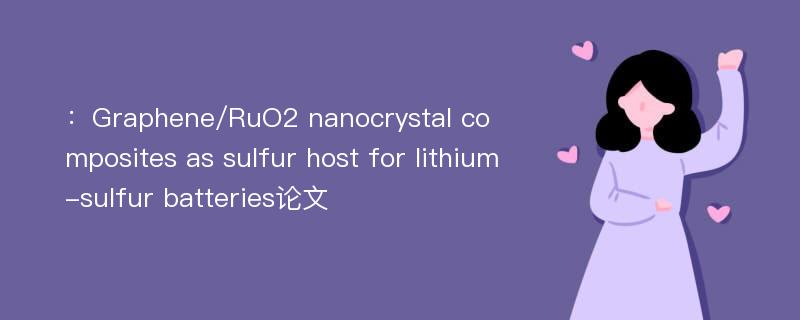
本文主要研究内容
作者(2019)在《Graphene/RuO2 nanocrystal composites as sulfur host for lithium-sulfur batteries》一文中研究指出:An optimized graphene/RuO2/S composite is prepared by hydrothermal growth of RuO2 particles on graphene oxide sheets as the positive electrode for rechargeable lithium-sulfur batteries. The electrode with 6.1 wt% RuO2 nanocrystals and a high sulfur content of 79.0 wt% delivers an optimal electrochemical performance with high residual capacities of 508 mAh g-1 after 200 cycles and 389 m Ah g-1 after800 cycles at 1 C with a low capacity decay of 0.054%. The RuO2 nanocrystals promote the redox reaction kinetics and facilitate the transformation of sulfur chemistry, leading to large improvements in reversibility and rate capability of the composite electrode. The density functional theory calculations signify the formation of Li–O and Ru–S bonds through chemical interactions between RuO2 and Li polysulfides while the adsorption energies between graphene and polysulfide species are much higher in the presence of RuO2 than that of the neat graphene acting alone. These discoveries support the efficient entrapment of polysulfides by the composite electrode to the benefit of enhanced cyclic stability of the battery.
Abstract
An optimized graphene/RuO2/S composite is prepared by hydrothermal growth of RuO2 particles on graphene oxide sheets as the positive electrode for rechargeable lithium-sulfur batteries. The electrode with 6.1 wt% RuO2 nanocrystals and a high sulfur content of 79.0 wt% delivers an optimal electrochemical performance with high residual capacities of 508 mAh g-1 after 200 cycles and 389 m Ah g-1 after800 cycles at 1 C with a low capacity decay of 0.054%. The RuO2 nanocrystals promote the redox reaction kinetics and facilitate the transformation of sulfur chemistry, leading to large improvements in reversibility and rate capability of the composite electrode. The density functional theory calculations signify the formation of Li–O and Ru–S bonds through chemical interactions between RuO2 and Li polysulfides while the adsorption energies between graphene and polysulfide species are much higher in the presence of RuO2 than that of the neat graphene acting alone. These discoveries support the efficient entrapment of polysulfides by the composite electrode to the benefit of enhanced cyclic stability of the battery.
论文参考文献
论文详细介绍
论文作者分别是来自Journal of Energy Chemistry的,发表于刊物Journal of Energy Chemistry2019年08期论文,是一篇关于,Journal of Energy Chemistry2019年08期论文的文章。本文可供学术参考使用,各位学者可以免费参考阅读下载,文章观点不代表本站观点,资料来自Journal of Energy Chemistry2019年08期论文网站,若本站收录的文献无意侵犯了您的著作版权,请联系我们删除。
